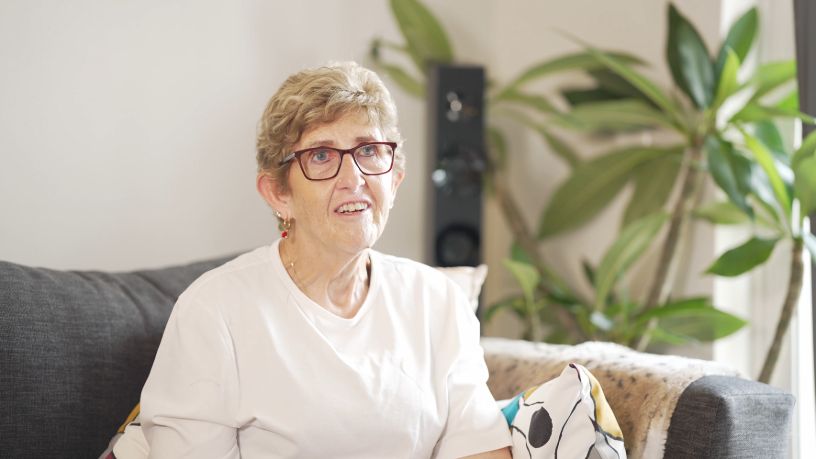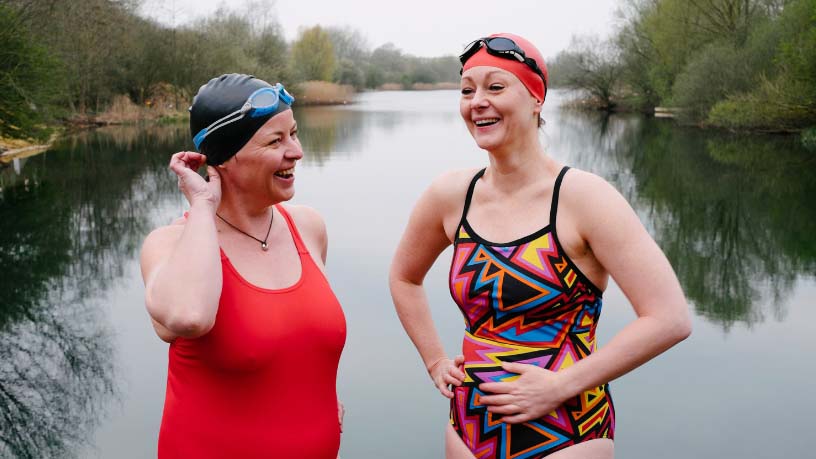Health guidelines recommend that people living with cancer exercise regularly to support their overall health and treatment outcomes.
On this page
Key takeaways
A combination of exercises may help you manage the side effects of treatments, improve physical and mental wellbeing and help to reduce cancer recurrence.
Everyone’s situation is unique, so speak to your doctor before starting a new exercise routine to ensure it can be tailored to your particular needs.
Exercising while you're undergoing cancer treatment might sound like the last thing you should be doing to support your recovery. But research shows that being active can help people living with cancer cope with the mental and physical impacts of their diagnosis and even improve treatment outcomes.1
Sydneysider Michelle Thompson knows how staying fit and strong can help in navigating some very tough times. Diagnosed with chronic lymphocytic leukaemia (CLL) in 2019, Michelle decided to support her own recovery by working on her fitness.
"I was overweight, with arthritis and osteopenia. I had chronic pain in my knees and could hardly walk. I knew if I was going to beat CLL, I needed to do something."
Michelle started an exercise and nutrition program with a local provider. Even after being diagnosed with colon cancer 2 years later, Michelle continues to train.
"I'd schedule my training days around my chemotherapy. I always felt better after exercising. As well as making me strong and fit, I made so many new friends and found a support system. It changed my life."
Exercising as part of cancer treatment
Health guidelines by the Clinical Oncology Society of Australia recommend that people living with cancer progress towards and then maintain "at least 150 minutes of moderate-intensity or 75 minutes of vigorous-intensity aerobic exercise (e.g. walking, jogging, cycling, swimming) each week; and 2 to 3 resistance exercise (e.g. lifting weights or resistance bands, body weight resistance exercises) sessions each week involving moderate to vigorous intensity exercises targeting the major muscle groups".1
Including exercise as a part of cancer treatment is something Dr David Mizrahi has dedicated the past 15 years to researching and developing.
"Two decades ago, there was a 'rest and protect' approach to cancer patients and a tendency to not let them overexert themselves while going through treatment. But we know that exercise is very helpful at improving patients' physical and mental health during cancer treatment, and they can actually live longer and lower the chances of cancer coming back."
Clinical trials are showing that patients who exercise also sleep better, have less fatigue and better heart function.
"Some studies are showing that they're actually having better treatment compliance and tolerance."
The benefits of exercise during cancer treatment
Orsi Kokai, founder and principal physiotherapist at Oncology Recovery Services Inc (ORSI) sees the physical and mental impacts of exercise therapy with her clients.
"Our primary goal is to help patients overcome physical limitations they experience during or after cancer treatment and we specialise in guiding patients to regain their strength and confidence in movement, with a particular focus on helping them return to and manage their daily activities effortlessly.
"Cancer treatment can cause fatigue, discomfort, and reduced flexibility or strength. We work to address these challenges through targeted exercise therapy, physiotherapy and massage therapy."
Can everyone exercise during treatment?
Orsi and her team work collaboratively with each client and their medical team to ensure that any exercise therapy is safe.
"While guidelines recommend exercise for all cancer patients, the specific exercise prescription must be individualised. Every patient's situation is unique, and exercise programs need to be tailored to their current abilities, treatment status and overall condition.
"Assessments are conducted by qualified health professionals with specific knowledge of cancer and exercise."
What types of exercise should a person with cancer be doing?
Different types of exercise can benefit us in different ways when undergoing medical treatment.
Cardiovascular exercise, like brisk walking uphill, jogging, cycling or an aerobics class, supports our heart and lung function, helps us maintain a healthy weight and lowers stress.2
Strength or resistance training won't only help improve posture, support muscle growth and protect joints from injury but can also increase balance, a crucial skill to maintain during cancer treatment, says Dr Mizrahi.3
"Some chemotherapy drugs can damage the nerves and cause patients to lose feeling in their hands or feet, which puts them at risk of a fall. Exercises such as standing on one foot near a wall with eyes closed, or on an unstable surface like a yoga mat can support overall strength and balance. Good balance can also help preserve a person's functional independence and mean they can still carry the shopping and lift the grandkids."
There are also proven mental health benefits of exercising while undergoing cancer treatments.4
"Some clients report that starting exercise therapy gives them back a sense of control. While cancer treatment left them feeling powerless, exercise sessions became something they could actively participate in and influence their recovery," says Orsi.
Should I exercise when I feel ill?
While Dr Mizrahi recommends everyone do some form of exercise, it is important to listen to your body and adjust the time and difficulty level.
"I give people 2 programs, A and B. If they're feeling good, we'll do program A which will challenge them and be a harder intensity for a longer duration. But, if they're not feeling good, we can scale it all the way back and just do something really simple and gentle."
Guidelines also recommend that those living with cancer start an exercise program immediately and not wait until treatment is over.1
"If someone is having surgery, or expecting months of treatment, that's a long time to not be exercising for. Exercise can help slow physical decline and help to maintain function, which is what we want to see. And something as simple as a 5-minute walk outside or some gentle weights at home can help increase an overall feeling of wellbeing."
Orsi agrees and creates bespoke training programs for clients depending on their immediate needs and health status.
"We often provide exercises that can be performed lying in bed, such as simple stretches combined with deep breathing."
A short walk with a friend can boost emotional wellbeing and foster connectivity.
"We encourage our patients to move to music as it can improve mood and motivation when regular exercises feel too daunting. We also recommend combining simple movement with meditation to help reduce anxiety, stress and depression commonly associated with cancer diagnosis and treatment."
How do I find the right exercise specialist?
If you're new to exercise, it's important that you find an experienced Accredited Exercise Physiologist or physiotherapist who has experience with cancer care and can help create a program to suit your needs and fitness levels.
"If someone has been doing exercise in the gym for their whole life, they may be at a lower risk of injury and may be able to self-motivate. For someone new to exercise it can take time to learn how to lift weights safely, so they will need more guidance," says Dr Mizrahi.
"It can also help to have a qualified person checking in with you as you progress because there can be a lot of changes throughout cancer treatment. Having a clear dialogue between the patient and the healthcare professional and maybe their medical team allows for the best clinical care for the patient."
Michelle, 64, is now cancer-free and says she is in the best shape of her life.
"A trainer at my gym calls me 'Wonder Woman' and that's how I feel."
Resources
Medicare provides up to 5 subsidised sessions to some patients with an AEP or physiotherapist under a Chronic Disease Management plan. Ask your GP for information.
Cancer Council provides examples of exercises you can do at home while undergoing cancer treatment, including how to stay safe and videos to follow.
Exercise and Sports Science Australia has a patient brochure listing specific cancers and the direct benefits of exercise for each. They also provide a search tool to find an Accredited Exercise Physiologist. Type 'cancer' into keyword filters to find a professional with relevant experience.
The Clinical Oncology Society of Australia created guidelines on exercise and cancer, including how often patients should exercise and how to reach out for help.
Thanks to: Dr David Mizrahi, Research Fellow and Accredited Exercise Physiologist, The Daffodil Centre, The University of Sydney, a joint Venture with Cancer Council NSW. David is the Chair of the Exercise and Cancer Executive Committee for the Clinical Oncology Society of Australia (COSA).
Orsi Kokai, founder and principal physiotherapist at Oncology Recovery Services Inc (ORSI).

At Bupa, trust is everything
Our health and wellbeing information is regularly reviewed and maintained by a team of healthcare experts, to ensure its relevancy and accuracy. Everyone's health journey is unique and health outcomes vary from person to person.
This content is not a replacement for personalised and specific medical, healthcare, or other professional advice. If you have concerns about your health, see your doctor or other health professional.
1Clinical Oncology Society of Australia. (2018). Australian Exercise and Cancer Guidelines. Clinical Oncology Society of Australia.
2Healthdirect. (2024). Cardiovascular exercise. Healthdirect.
3Better Health Channel. (2022). Resistance training – health benefits. Victoria State Government, Department of Health.
4Misiąg, W., Piszczyk, A., Szymańska-Chabowska, A., & Chabowski, M. (2022). Physical Activity and Cancer Care-A Review. Cancers, 14(17), 4154.
You might also like...
Exercise helped me survive cancer
Michelle was diagnosed with cancer at 60. Find out how sticking to a personalised exercise routine helped during her treatment.
Cancer: The importance of screening and early detection
Having regular health checks and screenings can help detect cancers early and improve survival rates. Learn about the common screening tests in Australia.
My journey with breast cancer
From diagnosis to treatment, learn all about one woman’s journey with breast cancer.
5 tips to start exercising (and stick with it)
Exercising regularly is one of the best things you can do for your health, but it’s not always easy to get started. Try these 5 tips to help get moving.





